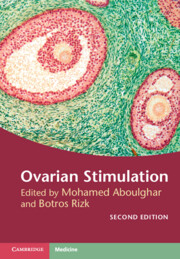Book contents
- Ovarian Stimulation
- Ovarian Stimulation
- Copyright page
- Dedication
- Contents
- Contributors
- About the Editors
- Foreword
- Preface to the first edition
- Preface to the second edition
- Section 1 Mild Forms of Ovarian Stimulation
- Section 2 Ovarian Hyperstimulation for IVF
- Section 3 Difficulties and Complications of Ovarian Stimulation and Implantation
- Section 4 Non-conventional Forms Used during Ovarian Stimulation
- Chapter 20 Adjuncts for Ovarian Stimulation
- Chapter 21 Luteinizing Hormone Supplementation during Ovarian Stimulation
- Chapter 22 Ovulation Induction for Hypogonadotropic Hypogonadism
- Section 5 Alternatives to Ovarian Hyperstimulation and Delayed Transfer
- Section 6 Procedures before, during, and after Ovarian Stimulation
- Index
- References
Chapter 22 - Ovulation Induction for Hypogonadotropic Hypogonadism
from Section 4 - Non-conventional Forms Used during Ovarian Stimulation
Published online by Cambridge University Press: 14 April 2022
- Ovarian Stimulation
- Ovarian Stimulation
- Copyright page
- Dedication
- Contents
- Contributors
- About the Editors
- Foreword
- Preface to the first edition
- Preface to the second edition
- Section 1 Mild Forms of Ovarian Stimulation
- Section 2 Ovarian Hyperstimulation for IVF
- Section 3 Difficulties and Complications of Ovarian Stimulation and Implantation
- Section 4 Non-conventional Forms Used during Ovarian Stimulation
- Chapter 20 Adjuncts for Ovarian Stimulation
- Chapter 21 Luteinizing Hormone Supplementation during Ovarian Stimulation
- Chapter 22 Ovulation Induction for Hypogonadotropic Hypogonadism
- Section 5 Alternatives to Ovarian Hyperstimulation and Delayed Transfer
- Section 6 Procedures before, during, and after Ovarian Stimulation
- Index
- References
Summary
Reproduction in humans is contingent upon the pulsatile secretion of gonadotropin-releasing hormone (GnRH) from the hypothalamus. This neuroendocrine activity results in the production and release of follicle-stimulating hormone (FSH) and luteinizing hormone (LH), and is essential therefore for proper steroidogenesis and gametogenesis within gonads.
- Type
- Chapter
- Information
- Ovarian Stimulation , pp. 208 - 222Publisher: Cambridge University PressPrint publication year: 2022



